
Ants are eusocial insects of the family Formicidae and, along with the related wasps and bees, belong to the order Hymenoptera. Ants evolved from vespoid wasp ancestors in the Cretaceous period. More than 13,800 of an estimated total of 22,000 species have been classified. They are easily identified by their geniculate (elbowed) antennae and the distinctive node-like structure that forms their slender waists.

Trophallaxis is the transfer of food or other fluids among members of a community through mouth-to-mouth (stomodeal) or anus-to-mouth (proctodeal) feeding. Along with nutrients, trophallaxis can involve the transfer of molecules such as pheromones, organisms such as symbionts, and information to serve as a form of communication. Trophallaxis is used by some birds, gray wolves, vampire bats, and is most highly developed in eusocial insects such as ants, wasps, bees, and termites.
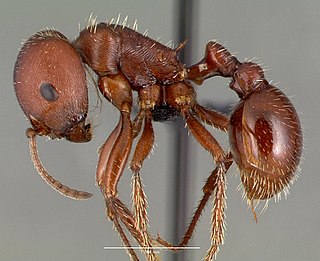
Pogonomyrmex barbatus is a species of harvester ant from the genus Pogonomyrmex. Its common names include red ant and red harvester ant. These large ants prefer arid chaparral habitats and are native to the Southwestern United States. Nests are made underground in exposed areas. Their diets consist primarily of seeds, and they consequently participate in myrmecochory, an ant-plant interaction through which the ants gain nutrients and the plants benefit through seed dispersal. Red harvester ants are often mistaken for fire ants, but are not closely related to any fire ant species, native or introduced.
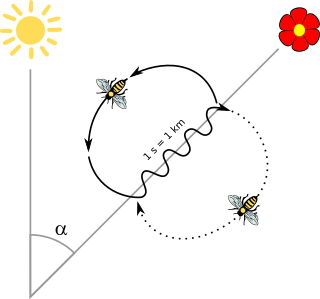
Waggle dance is a term used in beekeeping and ethology for a particular figure-eight dance of the honey bee. By performing this dance, successful foragers can share information about the direction and distance to patches of flowers yielding nectar and pollen, to water sources, or to new nest-site locations with other members of the colony.

Carpenter ants are large ants indigenous to many forested parts of the world.

The pharaoh ant is a small (2 mm) yellow or light brown, almost transparent ant notorious for being a major indoor nuisance pest, especially in hospitals. A cryptogenic species, it has now been introduced to virtually every area of the world, including Europe, the Americas, Australasia and Southeast Asia. It is a major pest in the United States, Australia, and Europe.
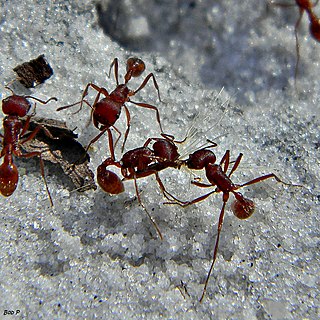
Harvester ant, also known as harvesting ant, is a common name for any of the species or genera of ants that collect seeds, or mushrooms as in the case of Euprenolepis procera, which are stored in the nest in communal chambers called granaries. They are also referred to as agricultural ants. Seed harvesting by some desert ants is an adaptation to the lack of typical ant resources such as prey or honeydew from hemipterans. Harvester ants increase seed dispersal and protection, and provide nutrients that increase seedling survival of the desert plants. In addition, ants provide soil aeration through the creation of galleries and chambers, mix deep and upper layers of soil, and incorporate organic refuse into the soil.

Tapinoma sessile is a species of small ant that goes by the common names odorous house ant, sugar ant, stink ant, and coconut ant. Their colonies are polydomous and polygynous. Like many social insects, T. sessile employs complex foraging strategies, allocates food depending on environmental conditions, and engages in competition with other insects.
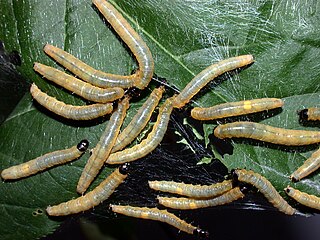
The collective behaviors of social caterpillars falls into five general categories: collective and cooperative foraging, group defense against predators and parasitoids, shelter building, thermoregulation and substrate silking to enhance steadfastness.

The Sahara Desert ant is a desert-dwelling ant of the genus Cataglyphis. It primarily inhabits the Sahara Desert and is one of the most heat tolerant animals known to date. However, there are at least four other species of Cataglyphis living in the Sahara desert, for example C. bombycina, Cataglyphis savignyi, Cataglyphis mauritanicus and C. fortis. Also, specimens of C. bicolor have been found well north of Sahara.

Myrmecophily is the term applied to positive interspecies associations between ants and a variety of other organisms, such as plants, other arthropods, and fungi. Myrmecophily refers to mutualistic associations with ants, though in its more general use, the term may also refer to commensal or even parasitic interactions.

Cataglyphis is a genus of ant, desert ants, in the subfamily Formicinae. Its most famous species is C. bicolor, the Sahara Desert ant, which runs on hot sand to find insects that died of heat exhaustion, and can, like other several other Cataglyphis species, sustain body temperatures up to 50°C. Cataglyphis is also the name of an autonomous rover that won the NASA Sample Return Robot Centennial Challenge inspired by the navigation approaches used by desert ants.

Formica polyctena is a species of European red wood ant in the genus Formica and large family Formicidae. The species was first described by Arnold Förster in 1850. The latin species name polyctena is from Greek and literally means 'many cattle', referring to the species' habit of farming aphids for honeydew food. It is found in many European countries. It is a eusocial species, that has a distinct caste system of sterile workers and a very small reproductive caste. The ants have a genetic based cue that allow them to identify which other ants are members of their nest and which are foreign individuals. When facing these types of foreign invaders the F. polyctena has a system to activate an alarm. It can release pheromones which can trigger an alarm response in other nearby ants.

The Saharan silver ant is a species of insect that lives in the Sahara Desert. It is the fastest of the world’s 12,000 known ant species, clocking a velocity of 855 millimetres per second. It can travel a length 108 times its own body length per second, a feat topped only by two other creatures, the Australian tiger beetle Cicindela eburneola and the California coastal mite Paratarsotomus macropalpis. This is nearly the walking pace of a human being, and compared to its body size would correspond to a speed of about 200 m/s (720 km/h) for a 180 cm (6 ft) tall human runner.
Trail pheromones are semiochemicals secreted from the body of an individual to affect the behavior of another individual receiving it. Trail pheromones often serve as a multi purpose chemical secretion that leads members of its own species towards a food source, while representing a territorial mark in the form of an allomone to organisms outside of their species. Specifically, trail pheromones are often incorporated with secretions of more than one exocrine gland to produce a higher degree of specificity. Considered one of the primary chemical signaling methods in which many social insects depend on, trail pheromone deposition can be considered one of the main facets to explain the success of social insect communication today. Many species of ants, including those in the genus Crematogaster use trail pheromones.

Tetragonisca angustula is a small eusocial stingless bee found in México, Central and South America. It is known by a variety of names in different regions. A subspecies, Tetragonisca angustula fiebrigi, occupies different areas in South America and has a slightly different coloration.
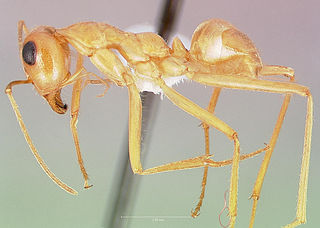
Myrmecocystus mexicanus is a species of ant in the genus Myrmecocystus, which is one of the six genera that bear the common name "honey ant" or "honeypot ant", due to curious behavior where some of the workers will swell with liquid food until they become immobile and hang from the ceilings of nest chambers, acting as living food storage for the colony. Honey ants are found in North America, Australia, and Africa. Ant species belonging to the genus Myrmecocystus reside in North America. M. mexicanus in particular is found in the southwestern United States and parts of Mexico.

Polybia occidentalis, commonly known as camoati, is a swarm-founding advanced eusocial wasp. Swarm-founding means that a swarm of these wasps find a nesting site and build the nest together. This species can be found in Central and South America. P. occidentalis preys on nectar, insects, and carbohydrate sources, while birds and ants prey on and parasitize them. P. occidentalis workers bite each other to communicate the time to start working.
Mischocyttarus drewseni, which is sometimes spelled "drewsenii", is a social wasp in the family Vespidae. It is commonly found in Neotropical regions of South America, including Brazil, Peru, Venezuela, Colombia and Paraguay. This mid-sized wasp is about 1.5-1.8 cm and is typically dark brown or black in color. This species makes their nests out of woody plant fibers and create single combed nests with hexagonal cells which are typically found in low lying grass habitats or semi-urban environments. The colony cycle for this species is initiated by the queen who starts building the nest cell by cell. The nest construction process is highly elaborate and involves foraging for materials, creating cells, and heightening cell walls. It feeds on arthropods, plant nectar, and honeydew, and the species is very protective of its brood when it comes to defending them from their predators. The life cycle of this species has several stages with varying lengths, including egg, larval, pupal, and adult stages. As a social wasp species, there are several castes within the colony and different castes perform different specialized jobs with differing dominance and reproductive behaviors.

Polybia sericea is a social, tropical wasp of the family Vespidae that can be found in South America. It founds its colonies by swarming migrations, and feeds on nectar and arthropods.
















